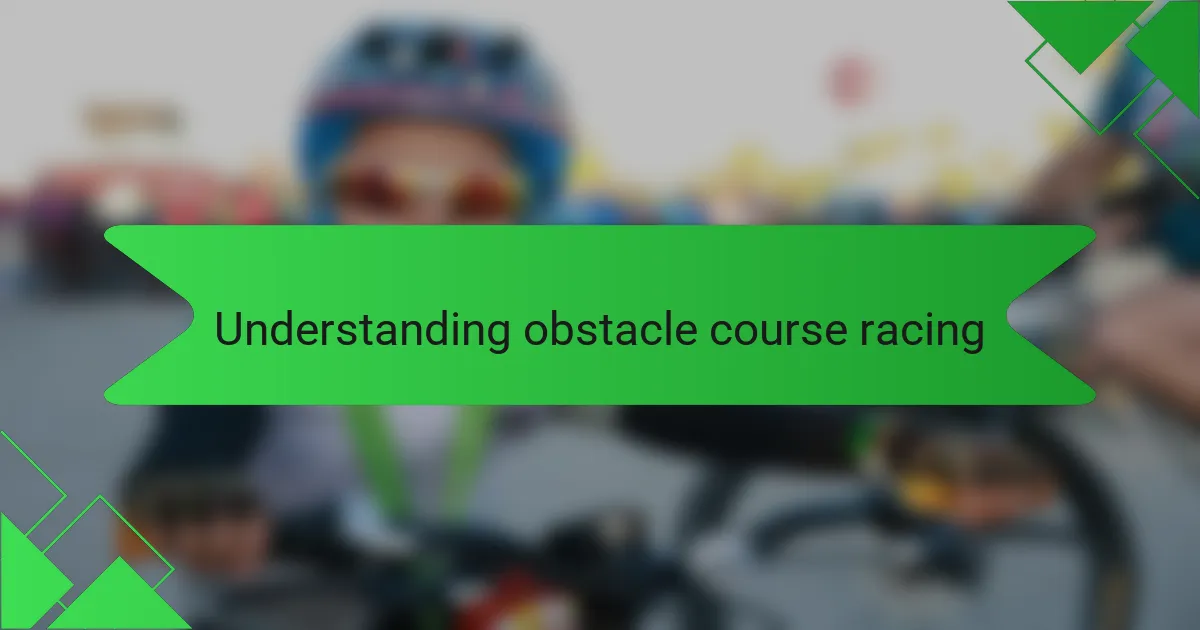Key takeaways
- Obstacle Course Racing combines physical strength, endurance, and mental toughness, requiring strategic planning during races.
- Preparation should include varied training techniques such as interval training, grip strength exercises, and simulating obstacles.
- Pacing and breaking down obstacles into manageable parts helps maintain focus and energy throughout the race.
- Strong community support and teamwork play a crucial role in overcoming challenges and enhancing the racing experience.

Understanding Obstacle Course Racing
Understanding Obstacle Course Racing has been a game-changer for me. I quickly realized it’s not just about speed but also strategy and mental toughness. Each race, especially the Savage Race, demands a mix of strength, agility, and the willingness to push past discomfort.
| Aspect | Explanation |
|---|---|
| Physical Demands | Combination of running, climbing, crawling, and jumping challenges endurance and strength. |
| Mental Challenges | Requires focus, problem-solving, and overcoming fear and fatigue. |
| Strategy | Knowing when to conserve energy and when to push hard is crucial for success. |
| Community | Strong camaraderie and support help keep motivation high throughout the race. |

Preparing for Savage Race Challenges
When I first tackled Savage Race challenges, my preparation was really about building endurance and functional strength. I found that it wasn’t just about running faster but being ready for everything—crawling through mud, climbing ropes, or hauling heavy objects. This varied approach kept me mentally alert and physically ready for the unpredictable nature of the course.
One thing I discovered is that mental toughness is as crucial as physical training. Visualizing the obstacles and reminding myself why I was doing this helped me push through moments of doubt. The sense of accomplishment at the finish line was worth every tough training session.
- Incorporate interval training to build stamina and recovery speed
- Practice grip strength exercises like pull-ups and farmer’s carries
- Include hill sprints and trail running to mimic uneven terrain
- Simulate obstacles at local gyms or parks whenever possible
- Focus on core stability to navigate crawling and climbing elements
- Develop a mental game plan to stay motivated during the race

Essential Gear for Savage Race
When I first started selecting gear for Savage Race, I quickly learned that the right shoes make all the difference. Trail running shoes with aggressive tread saved me from slipping on muddy slopes and provided the grip I needed during climbs. Have you ever tried running in slick shoes on uneven ground? Trust me, it’s a lesson you don’t want to learn mid-race.
Another piece of gear that became a game-changer for me was a pair of lightweight, moisture-wicking gloves. At first, I thought gloves would slow me down, but they actually improved my grip and protected my hands from abrasions on ropes and obstacles. Plus, they kept my hands warm during those early morning starts when the air was crisp and unforgiving.
I also couldn’t imagine racing without my compression gear. It supports my muscles, reduces fatigue, and minimizes chafing, which is crucial when you’re crawling through rough patches and pushing your body to the limit. Have you noticed how little things like that can sometimes make the biggest difference in endurance? For me, investing in quality, reliable gear gave me the confidence to tackle each obstacle without hesitation.

Training Techniques for Obstacle Courses
Training for Savage Race courses is all about building strength, agility, and endurance. I found that mixing traditional cardio with functional strength exercises—like burpees, pull-ups, and hiking hills—made a huge difference in how prepared I felt on race day. It’s tough but rewarding; the key is to push yourself without burning out.
One thing I learned the hard way was the value of grip strength. Early on, I struggled with obstacles that required hanging or climbing, so I started using farmer’s carries and dead hangs in my routine. Not only did my grip improve, but I also gained more confidence tackling those tricky obstacles.
| Training Technique | Benefit |
|---|---|
| Functional Strength | Enhances muscle endurance and obstacle performance |
| Cardiovascular Training | Improves stamina for long courses |
| Grip Strength Exercises | Boosts confidence and ability on hanging obstacles |

Strategies to Overcome Tough Obstacles
When I faced the Savage Race’s grueling obstacles, I found that breaking each challenge into small, manageable actions made a huge difference. Instead of feeling overwhelmed, I focused on one movement at a time, which helped me keep calm and push through, even when my muscles screamed for relief.
One strategy that truly saved me was pacing myself wisely; rushing led to mistakes and wasted energy. For example, on the rope climb, I paused midway to catch my breath and regain grip strength, which proved crucial. Here are some techniques I used to overcome tough obstacles:
- Analyze the obstacle before starting to plan your approach
- Use momentum strategically rather than relying solely on brute strength
- Break the obstacle into smaller steps to maintain focus
- Don’t hesitate to rest briefly to recover energy and composure
- Use your legs and core to assist your arms and reduce fatigue
- Stay positive and visualize yourself succeeding to build confidence

Managing Physical and Mental Endurance
Endurance in Savage Race isn’t just about physical stamina; it’s a mental battle I had to learn to win. There were moments when my legs felt like lead and my lungs burned, yet the toughest part was convincing my mind to keep going. Have you ever hit that wall where every step feels like a choice between giving up or pushing on? For me, building that mental resilience came from breaking the race into smaller milestones and celebrating each one.
Physically, managing energy throughout the course taught me the importance of pacing. Sprinting every segment sounded tempting, but I quickly realized it drained my reserves too fast. Instead, I settled into a rhythm—saving bursts of effort for trickier obstacles while cruising through easier parts. That balance between exertion and recovery was key to lasting through the muddy climbs and slippery descents.
I also found mindfulness helped me endure pain and fatigue. Focusing on breathing and staying present in the moment prevented my thoughts from spiraling into negativity. When my body screamed to stop, reminding myself why I started kept me moving forward. It’s fascinating how much mental endurance intertwines with physical toughness in these races—you really can’t have one without the other.

Lessons Learned from Savage Race Experience
Lessons learned from my Savage Race experience taught me the true meaning of resilience. Every obstacle pushed my limits, and I realized that mental toughness matters just as much as physical strength. I also found that pacing myself and staying focused helped me overcome the most intimidating challenges without losing steam.
Navigating the course revealed how essential teamwork and encouragement are. When I hit a wall—literally and figuratively—the support from fellow racers reignited my drive to keep going. This experience made me appreciate how Savage Race isn’t just a test of athleticism but a journey of personal growth.
| Lesson | Insight |
|---|---|
| Resilience | Overcoming each tough obstacle built my mental and physical stamina. |
| Pacing | Maintaining steady energy prevented burnout during the race. |
| Teamwork | Encouragement from others boosted my confidence when I struggled. |
